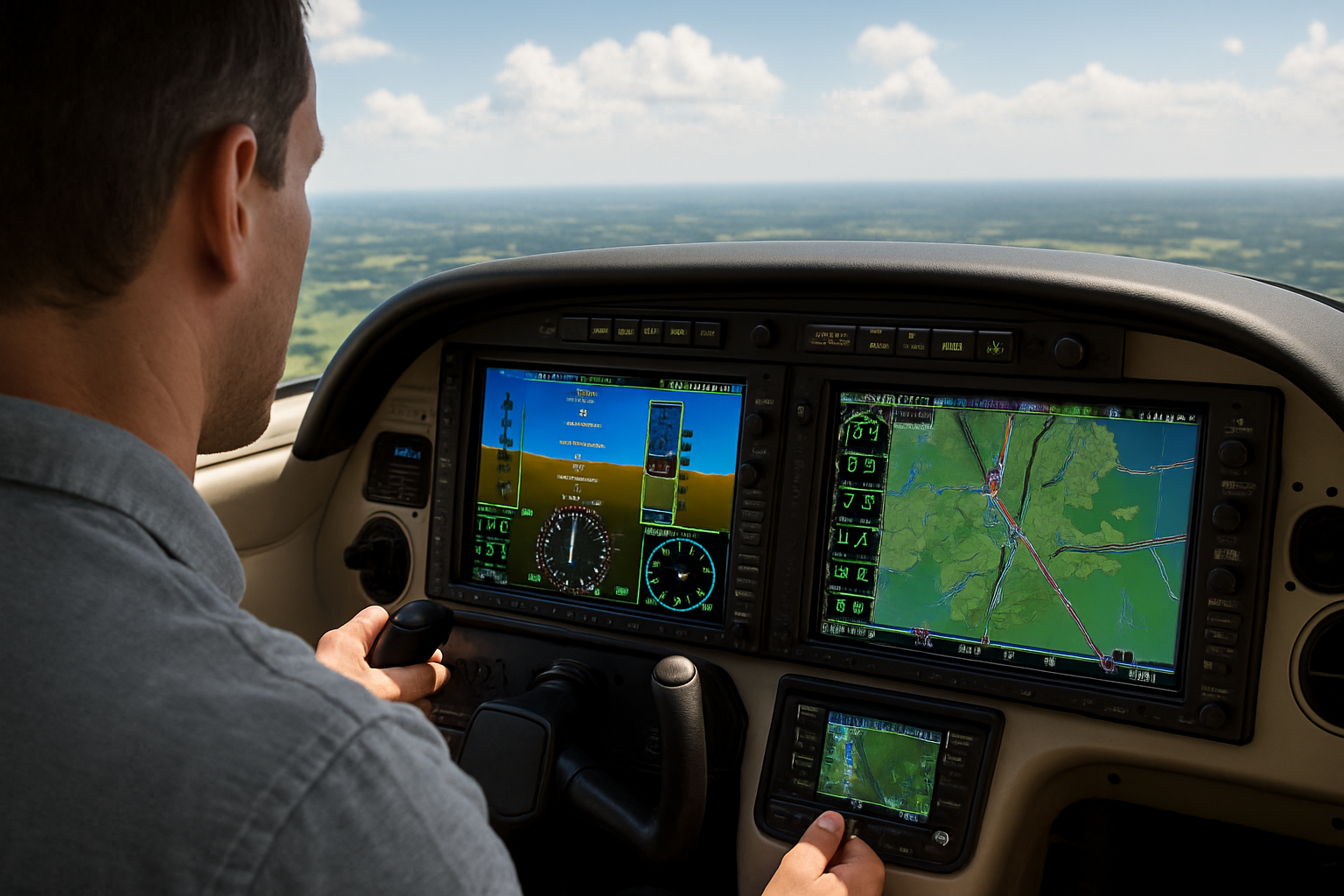Glass cockpits are one of the most important changes in general aviation over the last few decades. If you’re a student pilot or a newly certified private pilot, chances are you’ve already flown with one. But what exactly is a glass cockpit, and how is it changing the way we fly?
What Is a Glass Cockpit?
A “glass cockpit” refers to a flight deck that replaces traditional round-dial instruments (sometimes called “steam gauges”) with digital displays. These displays are usually large, color screens that combine multiple instruments into one user-friendly interface. The most common systems in general aviation include Garmin’s G1000 and Avidyne’s Entegra, though many other systems exist.
Instead of having six separate gauges showing airspeed, altitude, vertical speed, heading, attitude, and turn coordination, a glass cockpit will show all of these on one screen, often called the Primary Flight Display (PFD). Next to it, you’ll usually find a second screen called the Multi-Function Display (MFD), which can show engine data, maps, traffic, terrain, weather, and more.
Benefits of Glass Cockpits
1. Improved Situational Awareness
Glass cockpits give you a clearer picture of what’s going on around you. With synthetic vision, moving maps, and real-time weather, you can make better decisions faster. Being able to see your position relative to terrain or airspace makes it easier to avoid mistakes and stay safe.
2. Easier Navigation
Old-school VOR navigation took practice and mental math. Glass cockpits simplify this with GPS-based navigation, visual flight path cues, and intuitive direct-to functions. You can program a route and see it clearly displayed with waypoints, terrain, and airspace boundaries right on screen.
3. Better Engine Monitoring
The MFD shows detailed engine performance data. You’ll know your exact fuel flow, cylinder head temperatures, oil pressure, and more. This helps with fuel management and early detection of engine issues.
4. Safer Flight in Marginal Conditions
Although you should still avoid flying in poor weather unless you’re instrument-rated, the added awareness and synthetic vision tools can help you stay oriented if conditions start to change. Glass cockpits offer backup features that can be lifesavers in unexpected situations.
Challenges and Risks
1. Over-Reliance on Automation
One of the biggest concerns with glass cockpits is that they can lead pilots to rely too heavily on technology. It’s easy to become a “button pusher” instead of a hands-on pilot. This can be dangerous if the system fails or if you’re flying an aircraft with fewer features later on.
As a student pilot, it’s important to understand the systems you’re using, but also to be confident flying without them. Basic flying skills and good stick-and-rudder technique still matter.
2. Information Overload
Glass cockpits can display a lot of data at once. While that’s helpful, it can also be overwhelming. It’s tempting to spend too much time looking at the screen instead of looking outside. Remember, your primary job is to fly the airplane, not to manage a computer.
3. Higher Learning Curve
If you’re learning to fly in a glass cockpit, it might take longer to become comfortable with all the features. Even experienced pilots need training when switching to a new system. It’s important to get proper instruction and spend time learning the details of the system you’ll be using.
How to Train Effectively with a Glass Cockpit
- Get to know your system on the ground. Use simulators or training modules offered by manufacturers like Garmin or Avidyne. Many are free and available online.
- Practice flying with the screen off. Ask your instructor to cover the PFD and have you fly using backup instruments or partial panel techniques.
- Set up the displays for clarity. Don’t try to display everything at once. Focus on what’s most useful for each phase of flight.
- Learn how to use all the knobs and menus. Dig into the flight plan page, learn how to modify a route, and practice direct-to navigation. Know how to find nearest airports and change frequencies.
- Get used to “eyes outside” flying. Just because you have a moving map doesn’t mean you should ignore your surroundings. Scan for traffic, watch for weather, and maintain visual awareness.
Should You Learn to Fly with a Glass Cockpit?
There’s no right or wrong answer, but here are some things to consider:
- If you’re planning to fly mostly newer aircraft or transition to flying on instruments later, learning on a glass cockpit makes sense.
- If you plan to fly older rental aircraft or budget-friendly airplanes, it may be better to start with round gauges and learn glass later.
- If possible, try both. Learning to transition between the two makes you a more versatile pilot.
Final Thoughts
Glass cockpits are here to stay. They’re changing how pilots fly by offering more information, better awareness, and tools that make flying safer and more efficient. But they also come with a responsibility: to stay sharp, stay curious, and never forget the basics.
As a student or new private pilot, your job is to use technology as a tool, not a crutch. Understand your system, train with intention, and always be ready to take control. The best pilots are the ones who know how to manage both the airplane and the information.
Whether you’re flying behind a full-featured glass panel or a classic six-pack, your mindset and skill are what matter most. Fly safe, fly smart, and keep learning.
Sources:
– FAA: *Instrument Flying Handbook*
– Garmin G1000 Pilot’s Guide
– AOPA: *Transitioning to Glass Cockpits*
– Flight Training Magazine: *Digital Cockpits and the New Pilot Mindset*
Recent Posts
Autopilot is one of the most useful and misunderstood tools in a pilot’s toolbox. For many student and newly minted private pilots, autopilot may seem like something only used in airliners or...
The aviation world is changing, and electric aircraft are at the center of this transformation. For student pilots and new private pilots, this shift brings exciting opportunities along with a few...


